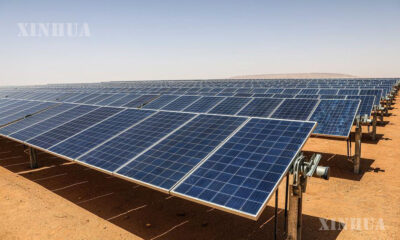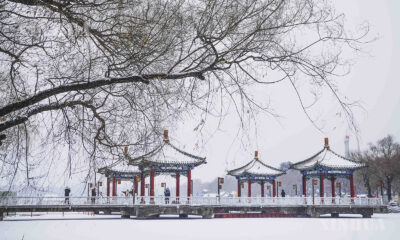Media
Shenzhou -13 အာကာသယာဉ်မှ ပြန်လည်ယူဆောင်လာသည့် အာကာသတွင်းပျိုးပွားခဲ့သည့် မျိုးစေ့များကို စတင်စိုက်ပျိုး
ဟူးဟောက်၊ မေ ၂၇ ရက် (ဆင်ဟွာ)
တရုတ်နိုင်ငံမှ သုတေသီများသည် Shenzhou-13 အာကာသယာဉ်အတွင်း အချိန် ၆ လတာ ပျိုးပွားခဲ့သည့် မျိုးစေ့ပေါင်း ၁၂,၀၀၀ ကို စမ်းသပ်စိုက်ပျိုးမှုစတင်ခဲ့သည်။
မျိုးစေ့များတွင် ပြီးခဲ့သည့်နှစ်က သုတေသန အဖွဲ့အစည်းပေါင်းများစွာက ရွေးချယ်ပေးခဲ့သည့် ပဲစေ့များ၊ အုတ်ဂျုံစေ့များနှင့် မှိုမျိုးစေ့များပါဝင်သည်။ ထိုမျိုးစေ့များကို ဧပြီ ၁၆ ရက်တွင် Shenzhou-13 အာကာသယာဉ်မှ ကမ္ဘာမြေပေါ်သို့ပြန်လည်ယူဆောင်လာခဲ့ခြင်းဖြစ်သည်။
အာကာသအတွင်း ပျိုးပွားခြင်းဆိုသည်မှာ မျိုးစေ့ဗီဇကို သန္ဓေပြောင်းရန်နှင့် မျိုးစိတ်အသစ်များအဖြစ် တစ်ဖန်ပြန်လည်စိုက်ပျိုးရန် ကမ္ဘာမြေသို့ ပြန်လည်ယူဆောင်လာရေး အာကာသခရီးစဉ်အတွင်း မျိုးစေ့များကို ကောမစ်ရောင်ခြည်ဖြာထွက်ခြင်းနှင့် အားနည်းသောကမ္ဘာမြေဆွဲအားနှင့် ထိတွေ့ခြင်းလုပ်ငန်းစဉ်ကို ဆိုလိုခြင်းဖြစ်သည်။
တရုတ်နိုင်ငံ၏ အာကာသစခန်းတည်ဆောက်ရေးစီမံကိန်း၏ အရေးပါသည့် နည်းပညာ အတည်ပြုသည့် အဆင့်၌ အာကာသတွင်းပျိုးပွားခြင်းစမ်းသပ်မှုကို အာကာသခရီးစဉ်အားလုံး၌ ထည့်သွင်းလုပ်ဆောင်ခဲ့သည်။ Shenzhou-12 နှင့် Shenzhou-13 အာကာသခရီးစဉ်များဖြင့် အဖွဲ့အစည်းပေါင်း ၈၈ ခုမှ ကောက်ပဲသီးနှံမျိုးစိတ် နှင့် ဇီဝသက်ရှိမျိုးစိတ်ပေါင်း ထောင်နှင့်ချီကို အာကာသအတွင်းသို့ ယူဆောင်သွားခဲ့ပြီးနောက် ကမ္ဘာမြေပေါ်သို့ပြန်လည်သယ်ဆောင်လာနိုင်ခဲ့သည်။
တရုတ်နိုင်ငံ (အတွင်း) မွန်ဂိုလီးယားကိုယ်ပိုင်အုပ်ချုပ်ခွင့်ရဒေသ မြောက်ပိုင်းရှိ နည်းပညာလုပ်ငန်းတစ်ခုဖြစ်သည့် M-Grass မှ သုတေသီများသည် Shenzhou-13 အာကာသယာဉ်ပေါ်တွင် မြက်မျိုးစိတ် ၆ မျိုးခန့်ကို လေ့လာစမ်းသပ်မှုလုပ်ဆောင်ခဲ့သည်။ ယင်းမှာ ၂၀၂၀ ပြည့်နှစ်တွင် ချန်အဲ-၅ လပေါ်သွားအာကာသယာဉ်ဖြင့် သန္ဓေပြောင်း မြက်မျိုးစိတ်များကို ကမ္ဘာမြေပေါ်သို့ ပြန်လည်ယူဆောင်လာခဲ့ပြီးနောက် ကုမ္ပဏီမှ အာကာသအတွင်းသို့ မျိုးစေ့များပို့ဆောင်သည့် ဒုတိယအကြိမ်ဖြစ်သည်။
မျိုးစေ့များကို ထပ်မံရွေးချယ်ခြင်းနှင့် စိုက်ပျိုးခြင်းတို့လုပ်ဆောင်ပြီးစီးပါက သာလွန်ကောင်းမွန်သည့် မျိုးစိတ်အမျိုးအစားများအား ဂေဟဗေဒ ပြန်လည်ထိန်းသိမ်းခြင်းနှင့် မြို့ပြ ဥယျာဉ်ခင်းကျင်းတည်ဆောက်ခြင်းလုပ်ငန်းများတွင် အသုံးပြုသွားမည်ဖြစ်ကြောင်း ကုမ္ပဏီမှ အကြီးတန်းသုတေသီဖြစ်သူ Liu Siyang က ဆိုသည်။
M-Grass မှ အကြီးတန်းသုတေသီဖြစ်သူ Liu Siyang
“ကျွန်တော်တို့ဟာ စိုက်ခင်းထဲမှာမျိုးစေ့အချို့ကိုစိုက်ပျိုးပါတယ်၊ တကယ်လို့ အဲဒီမျိုးစေ့တွေက အပင်ကောင်းကောင်းပေါက်လာပြီဆိုရင် တစ်ရှူးစိုက်ပျိုးနည်းစနစ်နဲ့ အချိန်တိုအတွင်းမှာအဲဒီမျိုးစေ့ကိုမျိုးပွားလိုက်မှာပါ၊ ဒီလိုနည်းနဲ့ အပင်မျိုးပွားခြင်းနဲ့ မျိုးစိတ်သစ်မျိုးစေ့ထုတ်လုပ်ခြင်း လုပ်ငန်းစဉ်တွေဟာတိုတောင်းလာမှာဖြစ်ပါတယ်၊ Shenzhou-13 အာကာသယာဉ်ခရီးစဉ်မှာ ကောက်နှံ စိုက်ပျိုးခြင်းကိုအားထုတ်လုပ်ဆောင်ခဲ့တာဖြစ်လို့ ကောက်ပဲသီးနှံ မျိုးစေ့အချိုးအစားက ပိုမိုကြီးမားလာခဲ့ပါတယ်” ဟုဆိုသည်။
၂၀၂၁ ခုနှစ် အောက်တိုဘာ ၁၆ ရက်တွင် Shenzhou-13 အာကာသယာဉ်ခရီးစဉ်၌ တရုတ်အာကာသယာဉ်မှူး ၃ ဦးလိုက်ပါပြီး တရုတ်အာကာသစခန်းပင်မခန်းတွင် အချိန် ၆ လကြာနေထိုင်မှုမှာ နိုင်ငံ၏ အာကာသတွင်းနေထိုင်ချိန် အကြာဆုံးလူလိုက်ပါသည့်အာကာသခရီးစဉ် ဖြစ်လာခဲ့သည်။ အာကာသယာဉ်မှူးများသည် အာကာသခရီးစဉ်အတွင်း မြောက်မြားလှစွာသော စမ်းသပ်မှုများကို အောင်မြင်ပြီးမြောက်အောင်လုပ်ဆောင်နိုင်ခဲ့သည်။ (Xinhua)
………………………………………
(English Version)
GLOBALink | Researchers start planting space-bred seeds returned by Shenzhou-13
HOHHOT, May 26 (Xinhua) — Chinese researchers have commenced breeding experiments on 12,000 seeds that were bred inside the Shenzhou-13 crewed spaceship in space for six months.
The seeds, including alfalfa, oats and fungi, were selected by multiple research institutions last year. They were brought back to Earth by the Shenzhou-13 on April 16.
Space breeding refers to the process of exposing seeds to cosmic radiation and microgravity during a spaceflight mission to mutate seed genes and then send them back to Earth to generate new species.
The space breeding tests have been carried out in all the flight missions during the essential technology verification phase of China’s space station project. Thousands of crop seeds and microorganisms from 88 organizations were carried into space and returned to Earth by the Shenzhou-12 and Shenzhou-13.
Researchers at M-Grass, a tech enterprise in north China’s Inner Mongolia Autonomous Region, have conducted experiments on six grass strains onboard the Shenzhou-13. It is the second time the company has sent seeds into space, following the return of grass specie mutations with the Chang’e-5 lunar probe in 2020.
After further selection and planting, superior seed varieties will be used for ecological restoration and urban landscape construction, said Liu Siyang, a senior researcher at the company.
“We plant some seeds in the field. If they perform well, we’ll multiply them in a short period of time by means of tissue culture. In this way, the cycle of propagation and industrialization of new varieties will become shorter. Since Shenzhou-13, we have focused on herbage cultivation, so the proportion of herbage seeds is larger.”
On Oct. 16, 2021, the Shenzhou-13 mission sent three taikonauts to China’s space station core module for a six-month stay — the longest-ever duration in the country’s crewed space program. Crew members completed several experiments during the space flight.
Produced by Xinhua Global Service






